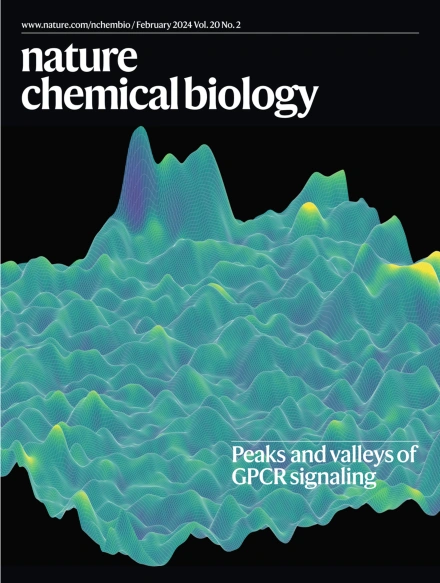Studying ATP synthesis in situ
IF 12.9
1区 生物学
Q1 BIOCHEMISTRY & MOLECULAR BIOLOGY
引用次数: 0
原位研究 ATP 合成
线粒体在补充用于提供细胞能量的分子--ATP 方面起着至关重要的作用。这是通过将质子(H+)穿过线粒体内膜的运动与氧化磷酸化最后一步中 ATP 合成酶的旋转运动紧密结合来实现的。线粒体内膜的褶皱被称为嵴,它提供了一个大的、离子不可渗透的表面区域,上面布满了呼吸酶,包括 ATP 合成酶二聚体。以前曾测定过分离的 ATP 合成酶的结构,并观察到将其重组到脂质体中后,会自发形成二聚体行,使脂质体膜弯曲;但 ATP 合成酶在其自然环境中的结构尚未测定,因为自然环境中保留了电化学质子梯度。现在,Dietrich 等人利用低温电子断层扫描(cryo-ET)技术,确定了单细胞藻类多孔菌(Polytomella)线粒体 ATP 合成酶的结构。研究小组观察到了平行排列的 ATP 合成酶二聚体,它们以左旋螺旋几何形状围绕嵴脊扭转。ATP 合成酶二聚体的排列决定了嵴的形状。
本文章由计算机程序翻译,如有差异,请以英文原文为准。
求助全文
约1分钟内获得全文
求助全文
来源期刊

Nature chemical biology
生物-生化与分子生物学
CiteScore
23.90
自引率
1.40%
发文量
238
审稿时长
12 months
期刊介绍:
Nature Chemical Biology stands as an esteemed international monthly journal, offering a prominent platform for the chemical biology community to showcase top-tier original research and commentary. Operating at the crossroads of chemistry, biology, and related disciplines, chemical biology utilizes scientific ideas and approaches to comprehend and manipulate biological systems with molecular precision.
The journal embraces contributions from the growing community of chemical biologists, encompassing insights from chemists applying principles and tools to biological inquiries and biologists striving to comprehend and control molecular-level biological processes. We prioritize studies unveiling significant conceptual or practical advancements in areas where chemistry and biology intersect, emphasizing basic research, especially those reporting novel chemical or biological tools and offering profound molecular-level insights into underlying biological mechanisms.
Nature Chemical Biology also welcomes manuscripts describing applied molecular studies at the chemistry-biology interface due to the broad utility of chemical biology approaches in manipulating or engineering biological systems. Irrespective of scientific focus, we actively seek submissions that creatively blend chemistry and biology, particularly those providing substantial conceptual or methodological breakthroughs with the potential to open innovative research avenues. The journal maintains a robust and impartial review process, emphasizing thorough chemical and biological characterization.
 求助内容:
求助内容: 应助结果提醒方式:
应助结果提醒方式:


